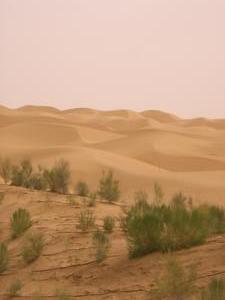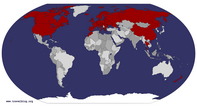Advertisement
Published: August 25th 2005

 Desert Irrigation!
Desert Irrigation!
The beautiful taklamakan and it's many miles of irrigated shrubs to prevent losing the road to the sand...Where am I:
To get to Qiemo, one must drive across the mighty Taklamakan desert. Thankfully the Chinese have engineered the longest complete-desert road in the world (500 km) through its interior of wind-blown dunes. This is thanks to a network of straw fencing and a reticulation system along its entire length to water some dune plants and prevent sand blowing over the road! Was this work done by machine or hand? “Machine” is the reply, and he quickly sketches a picture of a spade in the sand!!
The desert is an amazing place. Straying off the road several hundred metres, I am humbled by the forces at work here. Immediately I am out of touch of humans with a 360 degree panorama of golden sand dunes. My tracks are quickly covered over by the wind and I can see how people could disappear without a trace in this kind of environment! And the intense dry heat is ferocious. It is one of those dangerously charming and beautiful places; romantic, alluring and deadly!
Qiemo is the first sign of life and greenery for many hours. An oasis town, it is a quiet, but busy little town that owes it’s very

 Goodnight!
Goodnight!
One of the labourers working on the new vehicle access track beds down for the nightexistence to the Cherchen River, which flows north out of the Kunlun Range into the desert, providing a strip of thriving life to an otherwise barren and inhospitable environment. Street corners are piled up with melons for sale, the smell of BBQ-ing lamb and spices fills the air as donkeys pull carts through the pedestrian-friendly streets.
Into the field:
The old southern Silk Road skirts the southern edge of the Taklamakan along the divide with the Kunlun Range. It has recently been made redundant by a newer road about 80 km north of it and is slowly being buried by encroaching sand-dunes. However, this is the way to access the remote corner of this remote part of the world that will be home to 12 or so workers over the field season. About 100 km up this road, the jeep rumbles off onto a small track that follows a creek bed for 2 hours through some steep and impressive gorges, past herds of grazing dromedaries (the two-humped camels common in these parts), and into the mountains.
Base-camp is just shy of 3,000 m above sea level, situated on a loess covered mountain-side. This area sits right on the northern edge of
the 1 km wide suture zone between the Tarim Plate and the over-thrusting Tibetan Plate, which is being pushed up by the vigorous action of the Indian Plate, the carnage of which we call the Himalaya.
Beds are hard steel, with a thin cotton mattress (the blankets are thicker!) inside green military-style canvas tents. My newly purchased guitar (NZ$16) will provide my comfort here! Three meals a day are provided by our Chinese chef, whose specialties always seem to include some kind of wobbly animal organ!
From the valley floor at 2,500 m, mountains rise up to 5,500 m high in this area. Due to glacial and aeolian processes, huge quantities of loess have blanketed the area about 3 m thick!
Work:
Armed with a geological hammer, a map, GPS and some food, each day involves scrambling around the mountains looking for outcrops, sampling them, writing a description and using this information to make a map. Simple enough. As the youngest team member and one of the most experienced in the outdoors, my role here is to go places that the others don’t want to or can’t get to. This suits me fine as this generally involves a bit of climbing
and I get all the best views!
It all sounds very ideal, but after two days of field-work, things are all feeling a little repetitive. Hike around, find a rock, hit it, carry it with you to the next one. The scenery within the field area is pretty much of dust and loess and the same as far as the eye can see. This job will be fun for a time, but for a any decent length of time, it will do my head in!
After several day trips traversing ridges and climbing steep gullies, I have a fairly good overview of the terrain and I decide to head into the hills for a 3-4 day expedition. Now, trying to convince Chinese people, who have never been in mountains before let alone slept in a tent, that a 3-4 day trip is a good idea is hard work. Most of them don’t even believe it is possible.
“but you have no water!”
“there are many creeks and rivers.”
“but, where will you sleep?”
“we’ll find a place.” (I think they were after a booking number)
After several hours of back and forth, I finally convince

 Star!
Star!
we found ways to entertain ourselves...two of the field assistants (the strongest) to come along. Packing is hilarious. I have all the geo gear and my food and bedding requirements for a 4-day trip in a 55 litre pack. They have completely packed out 130 litres of pack space between them with about two weeks worth of food! One guy alone has 36 sausages and is planning to carry a 4 kg cardboard box full of milk in his hands!!! After negotiations, they are willing to cut back to about 10 days worth of food and take half as much milk, inside the pack. What escapes me is that they are concern because they feel that they can’t carry enough water for the whole trip, but they are sure that they will have enough to drink with the milk they are carrying!
Shortly after leaving behind the vehicle and outside influence for 3 days we find, in the side of the valley-wall, a small mud hut that provides home to a small Uyghur family who survive by farming sheep on the alpine meadows above. We are invited in for tea, yoghurt and some nan bread. The inside of the hut is decorated with carpets on
top of a raised earthen platform, and a small woodstove complete with chimney. They are fascinated by the camera, and only after a photo-shoot are we allowed to leave...
As the valley steepens, meadows start to become a rich of flowering blue and yellow. Families of large marmot-like creatures hurry around the place in comical, rodent-like fashion, their squeaks resounding through the valley as the walls close in around us. From the saddle (pass) at 3,780 m, I quickly run up a nearby peak (3,900 m!) to take a rock sample.
From here, we drop into a steep valley which we will follow until late on the second day, and will take us right into the heart of the 400 sq km field area. We are happy to find clean flowing water in the stream after several hours (although my camera's encounter with the stream was it's last), and in the late afternoon found a good spot to camp on a river terrace with a nice little pool nearby.
We have a map, but it is 1:100,000 from a satellite image, so the detail is poor at best, leaving GPS as the best means of navigating. Much
of the area that we are trying to access is totally unknown. On a number of occasions on day 2, I find myself climbing up some fairly interesting waterfalls up to 10 m in height, and then trying to figure the best way to get the others up. A lot of the time I felt more like a mountain guide than a geologist. There were many occasions when I found myself hanging off the edge of a small cliff, one of the fieldies hanging on the other end of my geological hammer, labouring and swearing in mandirin as he scratched his way up. But it was this that to me was the highlight of the work. Dealing with frequent complaints in Chinese was the flipside of this...
Day 3 involved a spectacular climb over yet another high peak, where I took a few moments to take in the 'geology' of the area. Right near the top was a large grass plateau area where a horse with long flowing mane ran free in a nice piece of symbology. Geologically, the last day was of little interest, but the wildlife came out to play. Donkeys, birds, marmots were all over. I

 Made it!
Made it!
The others thought there was no way... and we were all glad to get back!watched a team of Mt goats, all decked out with two foot long horns, as they traversed a steep marble face, sending down a shower of small stones. They seemed surprisingly scared and eager to leave after they saw me far below them. Not long after, we found a possible solution, as a new set of tracks appeared in the creek bed, of a wolf!
I took frequent dips in the stream in the hot afternoon sun as I had frequent opportunities while waiting for others… Back at camp by late afternoon, where, never has a melon been sweeter!
With a 'good' 8 hours on my metal-frame, I was ready to go again for one last field day. Halfway up a mountain, my two field assistants both decided that it was far too dangerous for them and turned back to camp. I continued and enjoyed being off alone in the mountains, free to think about myself and go where I want. That was until, walking up the creek bed, I came across a 10cm fresh cat-paw print in the mud. Looking back I noticed that my own prints hardly left an impression, and comparing it with the 3cm deep

 Leaving it all behind
Leaving it all behind
screaming across the desert with the Kunlun Range in the backdropprint in front of me, decided; "That is one big animal!"
I turned around and headed for the proposed meeting point at a stream junction and, needless to say, kept a weary eye out over my shoulder. It was not the most relaxed 3 hours of my life, and I arrived at the pick up point 1.5 hours early! Relating the story at camp, I was told it was most likely a snow leopard. These are rare and beautiful creatures that can rip you apart before you even know that they are there! I feel privileged.
On our final night in camp, it rained almost continuously all night, which made things really cold, muddy and the streams and rivers were up the next day. This made for an interesting drive out, as any semblance of a road was gone. It was a fantastic cross between some fairly full-on four-wheel-drive-ing and a jet boat ride. My kayaking experience came in useful for navigation as no-one had any idea how to read the flow of the river, and all were stoked to make it!
The desert after rain is truly beautiful as colours become so rich and the fresh snow on the mountains topped it off. It wasn't without a little sorrow that I was leaving behind this area after a great two week period... Although at no point did I really change my mind about leaving, as the politics, beauracracy and an inability to find common ground with anyone, was going to make me snap!
Advertisement
Tot: 0.074s; Tpl: 0.012s; cc: 6; qc: 24; dbt: 0.0253s; 1; m:domysql w:travelblog (10.17.0.13); sld: 1;
; mem: 1.1mb









